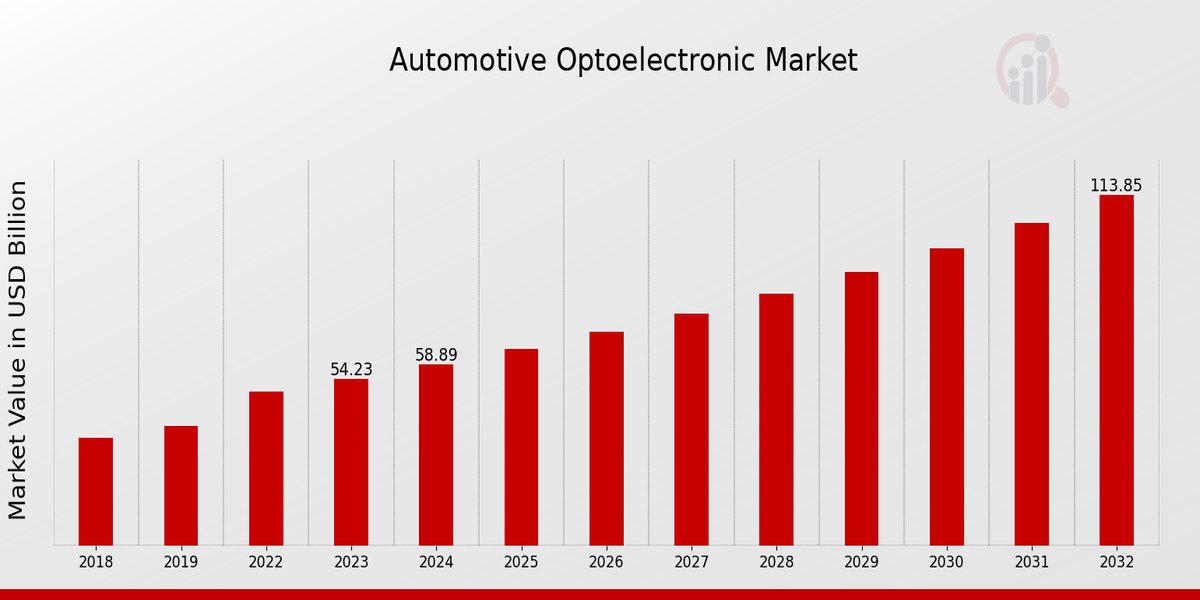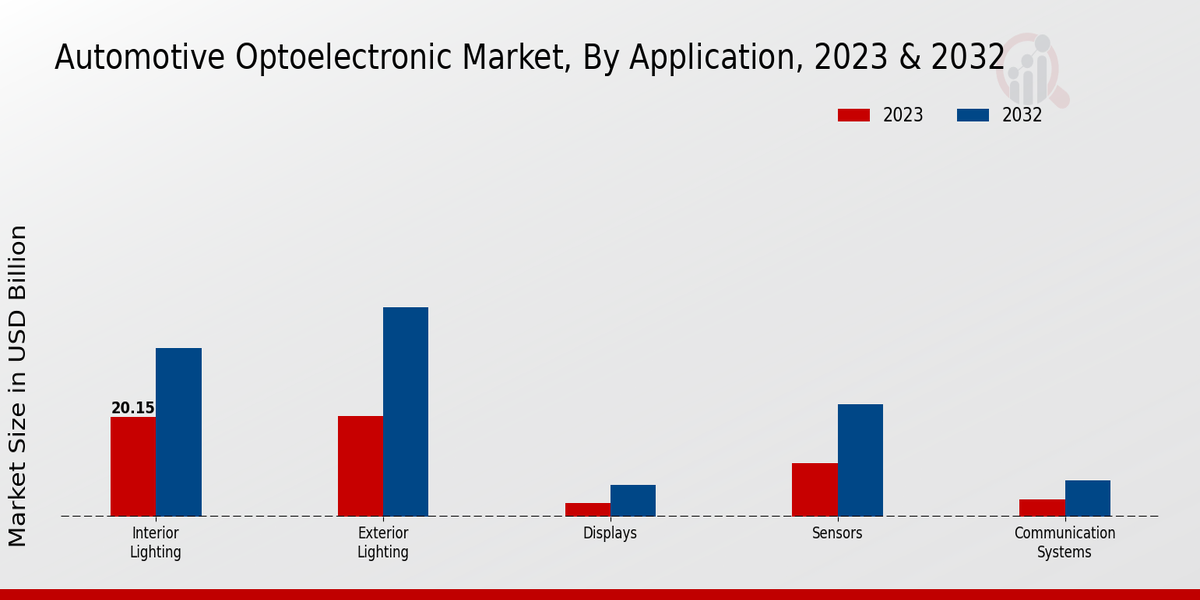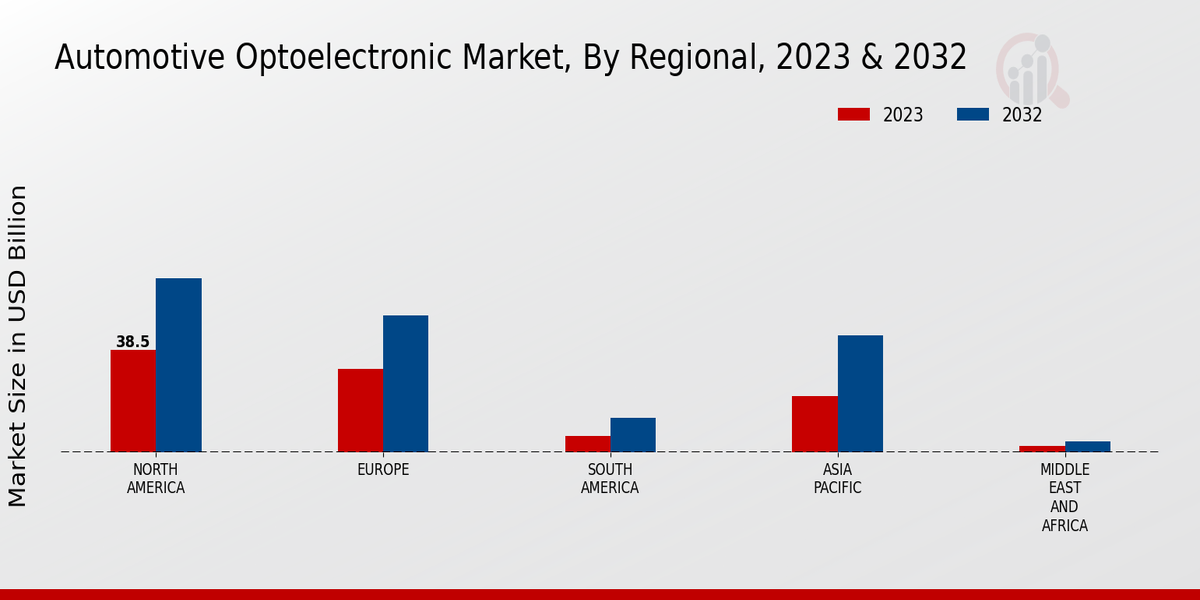Automotive Optoelectronic Market Overview
As per MRFR analysis, the Automotive Optoelectronic Market Size was estimated at 63.95 (USD Billion) in 2024. The Automotive Optoelectronic Market Industry is expected to grow from 69.44 (USD Billion) in 2025 to 145.82 (USD Billion) till 2034, at a CAGR (growth rate) is expected to be around 8.59% during the forecast period (2025 - 2034).
Key Automotive Optoelectronic Market Trends Highlighted
Rising player activities in regions such as North America, Europe, Middle East and Africa (EMEA) and Asia are propelling the growth of automotive optoelectronics markets. Stringent government DOT regulations fostering passenger safety, a rise in demand for ADAS, increase in electric vehicle adoption are key market drivers for the automotive optoelectronics market.
In terms of opportunities to be captured, organic polymer adoption will increase subassembly operations on flex-rigid substrates, while the adoption of new technologies will deepen the penetration of optoelectronic systems, including AI and ML techniques. They also include understanding and addressing foreign customers as their automotive production increases rapidly.
Other increasing recent developments and market trends in the automotive optoelectronics market are the use of light-emitting diodes and laser diodes in headlamps, tail lamps and any interior light fittings, the design and application of sensors and cameras for ADAS function and more technologically advanced displays and User Interface components.

Source: Primary Research, Secondary Research, MRFR Database and Analyst Review
Automotive Optoelectronic Market Drivers
Rising Demand for Advanced Driver Assistance Systems (ADAS)
ADAS stands for a collection of technologies aimed at improving the safety and functionality of the vehicle. Such systems are largely based on optoelectronic devices such as sensors, cameras, and LiDAR that observe the surrounding environment of the vehicle to collect information and respond to the requirements in real-time. The increasing acceptance of the ADAS features including lane departure warning, adaptive cruise control, and autonomous emergency braking, are positively impacting the growth of the automotive optoelectronics in the Automotive Optoelectronic Market Industry.
There are various merits accruing to drivers and passengers with the implementation of ADAS systems. There is a possibility of preventing some of the accidents, decreasing the drowsy nature of the drivers, and generally making the experience enjoyable. With an increase in the level of autonomy in vehicles, there will be a corresponding increase in demand for complex and robust optoelectronic elements. These reasons are likely to encourage market optimism for the growth of the automotive optoelectronic market in the near future.
Increasing Popularity of Electric Vehicles (EVs)
The increasing adoption of electric vehicles (EVs) is one more reason for the growth of the automotive optoelectronic components market. The batteries inside the EVs call for certain specific energy optoelectronics that can handle altered electrical and heat conditions presented by electric powertrain systems. Such items consist of high brightness homed Head limiting & Warning LEDs for headlamps and tail lamps, sensors to monitor and manage batteries, and instrument cluster displays. The movement towards electrification is being propelled by the public's unwavering call for greener strategies, by obliging laws, and by users needing pollution-free alternatives.
With the rising penetration of EVs on the road, the automotive optoelectronic components market is going to expand, too.
Technological Advancements in Optoelectronic Materials and Devices
Ongoing advancements in optoelectronic materials and devices are also contributing to the growth of the automotive optoelectronic market. These advancements include the development of new materials with improved optical properties, higher efficiency, and lower cost. Additionally, the miniaturization and integration of optoelectronic devices are enabling the development of smaller, more compact, and more cost-effective systems. These technological advancements are paving the way for new and innovative applications of optoelectronics in the automotive industry.
For example, the use of advanced optoelectronic materials in LED lighting systems is improving visibility and safety on the road. Similarly, the integration of optoelectronic devices into sensors and displays is enabling the development of more sophisticated and user-friendly human-machine interfaces.
Automotive Optoelectronic Market Segment Insights
Automotive Optoelectronic Market Application Insights
Application The automotive optoelectronic market is segmented into various applications, including interior lighting, exterior lighting, displays, sensors, and communication systems. Interior lighting accounts for the largest share of the market, driven by the increasing demand for ambient lighting, advanced driver assistance systems (ADAS), and infotainment systems. Exterior lighting is another significant segment, primarily influenced by the adoption of LED and OLED technologies for headlamps, taillamps, and signal lights. Displays are gaining traction in the automotive industry, particularly with the integration of advanced human-machine interfaces (HMIs) and digital dashboards.
Sensors play a crucial role in autonomous driving and safety features, such as night vision systems, blind-spot detection, and adaptive cruise control. Communication systems enable connectivity and data exchange between vehicles, infrastructure, and other devices, supporting applications such as vehicle-to-vehicle (V2V) and vehicle-to-infrastructure (V2I) communication. The Automotive Optoelectronic Market revenue for 2024 is estimated to be around 56.73 billion USD, exhibiting a steady growth rate in the coming years. The market segmentation provides insights into the specific applications and their contribution to the overall industry, enabling stakeholders to make informed decisions and target specific segments for growth opportunities.

Source: Primary Research, Secondary Research, MRFR Database and Analyst Review
Automotive Optoelectronic Market Light Source Insights
The Light Source segment plays a crucial role in the Automotive Optoelectronic Market, with its components being essential for various lighting and display applications in vehicles. Among the sub-segments, LEDs (Light Emitting Diodes) hold a significant market share due to their energy efficiency, long lifespan, and compact size. In 2023, the LED sub-segment was valued at USD 24.53 billion and is projected to grow at a CAGR of 9.1% during the forecast period 2023-2032. Lasers are another important sub-segment, particularly in advanced driver assistance systems (ADAS) and autonomous vehicles.
The growing demand for lidar and other sensing technologies is driving the growth of the laser sub-segment, which is expected to reach a valuation of USD 12.65 billion by 2032. OLEDs (Organic light-mitting diodes) are gaining traction in the automotive industry for their superior display capabilities, offering high contrast ratios and wide viewing angles. The increasing adoption of digital dashboards and infotainment systems is contributing to the growth of the OLED sub-segment, which is projected to reach a valuation of USD 6.32 billion by 2032.
Incandescent lamps and fluorescent tubes, while still used in some legacy applications, are gradually being replaced by more advanced and energy-efficient light sources. The market for these sub-segments is expected to decline in the coming years.
Automotive Optoelectronic Market Vehicle Type Insights
The Vehicle Type segment of the Automotive Optoelectronic Market is segmented into Passenger Cars, Commercial Vehicles, Two-Wheelers, Electric Vehicles, and Hybrid Vehicles. Among these segments, Passenger Cars held the largest market share in 2023, accounting for over 55% of the Automotive Optoelectronic Market revenue. The growth of this segment is attributed to the increasing production and sales of passenger cars worldwide. Commercial Vehicles are expected to witness significant growth in the coming years due to the rising demand for goods transportation and logistics services.
Two-wheelers are expected to grow at a steady pace, driven by the increasing popularity of motorcycles and scooters in developing countries. Electric Vehicles and Hybrid Vehicles are expected to gain traction in the coming years due to government initiatives and consumer awareness about environmental concerns. Overall, the Vehicle Type segment is expected to contribute significantly to the growth of the Automotive Optoelectronic Market in the coming years.
Automotive Optoelectronic Market End Use Insights
The Automotive Optoelectronic Market segmentation by End Use comprises OEMs, Aftermarket, Fleet Operators, and Retail Consumers. Among these segments, OEMs are expected to account for the largest revenue share in the Automotive Optoelectronic Market. This dominance is primarily due to the rising adoption of advanced lighting technologies in new vehicles to enhance safety and aesthetic appeal. The Aftermarket segment is anticipated to exhibit a significant growth rate over the forecast period. This growth can be attributed to the increasing demand for replacement and upgrade of automotive lighting systems.
Fleet Operators are focusing on improving vehicle efficiency and reducing maintenance costs, driving the demand for automotive optoelectronic solutions. Retail Consumers are becoming more conscious of safety and personalization, leading to the growing popularity of aftermarket lighting accessories.
Automotive Optoelectronic Market Connection Type Insights
The Automotive Optoelectronic Market is segmented into Wired, Wireless, and Fiber Optic based on Connection Type. The Wired segment held the largest market share in 2023 and is expected to continue its dominance during the forecast period. This can be attributed to the high reliability and low cost of wired connections. However, the Wireless segment is expected to grow at the highest CAGR during the forecast period, owing to the increasing adoption of wireless technologies in the automotive industry. The Fiber Optic segment is also expected to grow at a significant rate during the forecast period due to its ability to provide high-speed data transmission over long distances.
Automotive Optoelectronic Market Regional Insights
The regional landscape of the Automotive Optoelectronic Market presents distinct variations in market size and growth dynamics. North America holds a significant market share, driven by the presence of major automotive manufacturers and advanced technological infrastructure. In 2023, North America accounted for approximately 38.5% of the Automotive Optoelectronic Market revenue. Europe follows closely, capturing a market share of around 31.2%. The region benefits from a strong automotive industry and government initiatives promoting energy efficiency and safety.
The Asia-Pacific (APAC) region is projected to witness the fastest growth, owing to the increasing production of automobiles and the growing adoption of advanced lighting systems. South America and the Middle East and Africa (MEA) are expected to contribute modestly to the overall market growth. Market players in these regions are focusing on expanding their presence and introducing innovative solutions to cater to the evolving demands of the automotive industry.

Source: Primary Research, Secondary Research, MRFR Database and Analyst Review
Automotive Optoelectronic Market Key Players And Competitive Insights
Major players in the Automotive Optoelectronic Market industry are constantly striving to gain a competitive edge by introducing innovative products and technologies. Leading Automotive Optoelectronic Market players are focusing on developing advanced optoelectronic components and systems that meet the evolving demands of the automotive industry. The Automotive Optoelectronic Market development landscape is characterized by strategic partnerships, acquisitions, and joint ventures as companies seek to expand their market reach and strengthen their technological capabilities. The Competitive Landscape of the Automotive Optoelectronic Market is expected to remain dynamic in the coming years, driven by the increasing demand for advanced lighting and sensor technologies in vehicles.
A notable example of a leading Automotive Optoelectronic Market company is Automotive Lighting. The company has a strong focus on innovation and technology, and it has a comprehensive portfolio of products and systems for automotive lighting. Automotive Lighting has a presence, and it supplies its products to major automakers worldwide. The company's commitment to research and development has enabled it to maintain a strong position in the Automotive Optoelectronic Market.
Another key player in the Automotive Optoelectronic Market is Osram Opto Semiconductors. The company has a long history of innovation in optoelectronics, and it offers a wide range of products and solutions for automotive applications. Osram Opto Semiconductors has a strong focus on quality and reliability, and it has a network of manufacturing and sales facilities. The company's commitment to customer satisfaction has made it a trusted partner for many automotive manufacturers.
Key Companies in the Automotive Optoelectronic Market Include:
-
Nichia Corporation
-
Everlight Electronics Co., Ltd.
-
Valeo S.A.
-
Lumileds Holding B.V.
-
IIVI Incorporated
-
Seoul Semiconductor Co., Ltd.
-
Samsung Electronics Co., Ltd.
-
Osram Opto Semiconductors GmbH
-
Cree, Inc.
-
Toyoda Gosei Co., Ltd.
-
Broadcom Inc.
-
ROHM Co., Ltd.
-
AMS AG
-
Infineon Technologies AG
Automotive Optoelectronic Market Industry Developments
The automotive optoelectronics market is projected to reach USD 145.82 billion by 2034, exhibiting a CAGR of 8.59% from 2025 to 2034. The market growth is attributed to the rising demand for advanced driver assistance systems (ADAS), autonomous vehicles, and the increasing adoption of electric vehicles. Key market trends include the integration of sensors and cameras for improved safety features, the development of advanced lighting systems, and the growing adoption of automotive electronics. Recent developments include the launch of new products, such as high-resolution cameras and lidar sensors, by major players in the market. Strategic partnerships and collaborations between automotive manufacturers and technology providers are also shaping the market landscape.
Automotive Optoelectronic Market Segmentation Insights
-
Automotive Optoelectronic Market Application Outlook
-
Interior Lighting
-
Exterior Lighting
-
Displays
-
Sensors
-
Communication Systems
-
Automotive Optoelectronic Market Light Source Outlook
-
LEDs
-
Lasers
-
OLEDs
-
Incandescent Lamps
-
Fluorescent Tubes
-
Automotive Optoelectronic Market Vehicle Type Outlook
-
Passenger Cars
-
Commercial Vehicles
-
Two-Wheelers
-
Electric Vehicles
-
Hybrid Vehicles
-
Automotive Optoelectronic Market End Use Outlook
-
OEMs
-
Aftermarket
-
Fleet Operators
-
Retail Consumers
-
Automotive Optoelectronic Market Connection Type Outlook
-
Wired
-
Wireless
-
Fiber Optic
-
Automotive Optoelectronic Market Regional Outlook
-
North America
-
Europe
-
South America
-
Asia Pacific
-
Middle East and Africa
| Report Attribute/Metric |
Details |
|
Market Size 2024
|
63.95 (USD Billion)
|
|
Market Size 2025
|
69.44 (USD Billion)
|
|
Market Size 2034
|
145.82 (USD Billion)
|
|
Compound Annual Growth Rate (CAGR)
|
8.59% (2025 - 2034)
|
|
Report Coverage
|
Revenue Forecast, Competitive Landscape, Growth Factors, and Trends
|
|
Base Year
|
2024
|
|
Market Forecast Period
|
2025 - 2034
|
|
Historical Data
|
2019 - 2023
|
| Market Forecast Units |
USD Billion |
| Key Companies Profiled |
Nichia Corporation, Everlight Electronics Co., Ltd., Valeo S.A., Lumileds Holding B.V., IIVI Incorporated, Seoul Semiconductor Co., Ltd., Samsung Electronics Co., Ltd., Osram Opto Semiconductors GmbH, Cree, Inc., Toyoda Gosei Co., Ltd., Broadcom Inc., ROHM Co., Ltd., AMS AG, Infineon Technologies AG |
| Segments Covered |
Application, Light Source, Vehicle Type, End Use, Connection Type, Regional |
| Key Market Opportunities |
Increasing demand for autonomous vehicles, growing adoption of advanced driver-assistance systems ADAS rising popularity of electric vehicles, expanding automotive industry in emerging economies, technological advancements in optoelectronic components |
| Key Market Dynamics |
Autonomous Vehicle Advancement Electrification of Vehicles Increasing Demand for Safety Features Government Regulations for Automotive Lighting Standards Growing Adoption of Advanced Driver Assistance Systems ADAS |
| Countries Covered |
North America, Europe, APAC, South America, MEA |
Frequently Asked Questions (FAQ) :
The automotive optoelectronics market is expected to reach USD 145.82 billion by 2034, growing at a CAGR of 8.59% from 2025 to 2034.
North America is expected to hold the largest share of the automotive optoelectronic market, followed by North America and Europe.
The growth of the automotive optoelectronics market is driven by the increasing demand for advanced driver assistance systems (ADAS) and autonomous vehicles.
Major players in the automotive optoelectronic market include Osram, HELLA, and Koito.
Key trends shaping the automotive optoelectronic market include the development of solid-state lighting (SSL) and the integration of optoelectronics into vehicle interiors.
Government regulations on vehicle safety and emissions are driving the demand for automotive optoelectronic technologies.
Advancements in LED and OLED technologies are enabling the development of more efficient and innovative automotive lighting systems.
Challenges faced by the automotive optoelectronic market include the high cost of development and the need for robust designs to withstand harsh automotive environments.
Growth opportunities for the automotive optoelectronic market lie in the increasing adoption of autonomous vehicles and the development of new applications for optoelectronics in vehicles.
The future outlook for the automotive optoelectronic market is positive, driven by the increasing adoption of ADAS and autonomous vehicles, as well as the development of new technologies.

















